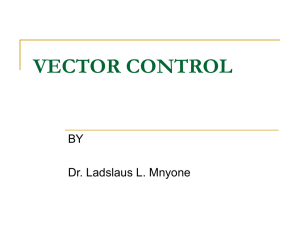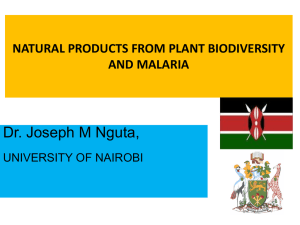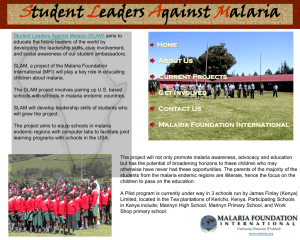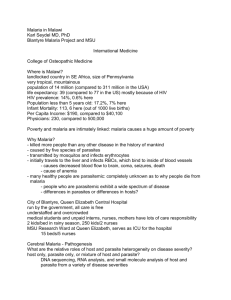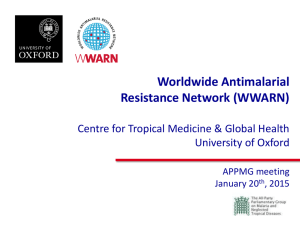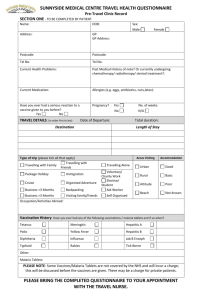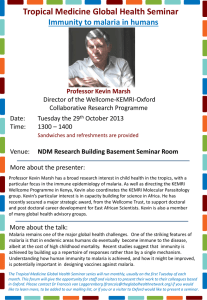Y7 Annual Report Oct 2014-Sept 2015
advertisement
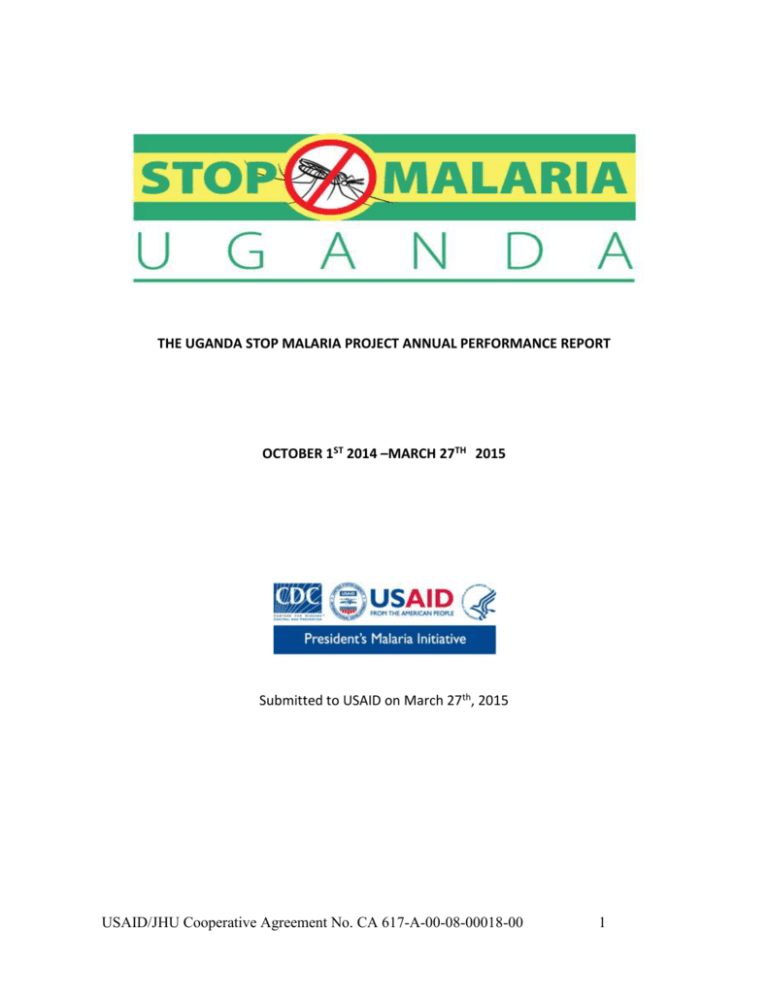
THE UGANDA STOP MALARIA PROJECT ANNUAL PERFORMANCE REPORT OCTOBER 1ST 2014 –MARCH 27TH 2015 Submitted to USAID on March 27th, 2015 USAID/JHU Cooperative Agreement No. CA 617-A-00-08-00018-00 1 Table of Contents LIST OF ACRONYMS ...............................................................................................................................................3 EXECUTIVE SUMMARY .........................................................................................................................................5 BACKGROUND ..........................................................................................................................................................7 RESULTS FRAMEWORK ........................................................................................................................................8 PROJECT ACHIEVEMENTS ...................................................................................................................................9 IR 1.1: MALARIA RELATED POLICIES AND GUIDELINES OPERATIONALIZED........................................9 IR 1.3: ACCESS TO LLINS INCREASED ............................................................................................................. 12 IR 2: MALARIA DIAGNOSIS AND TREATMENT ACTIVITIES IN SUPPORT OF THE NATIONAL MALARIA STRATEGY IMPROVED AND IMPLEMENTED ............................................................................ 13 IR 2.1: MALARIA DIAGNOSTIC TREATMENT AND REFERRAL SERVICES IMPROVED ........................ 13 IR 2.2: MALARIA DIAGNOSTIC CAPACITY AND SERVICES IMPROVED ................................................. 14 IR 3: NMCP CAPACITY TO MONITOR AND EVALUATE INTERVENTIONS STRENGTHENED .............. 14 IR 3.1: TECHNICAL RESOURCES AND SKILLS OF MONITORING AND EVALUATION (M&E) SUBUNIT IMPROVED ................................................................................................................................................. 14 IR 3.2: COLLECTION, PROCESSING AND USE OF DATA FROM DISTRICTS AND IMPLEMENTING PARTNERS IMPROVED ...................................................................................................................................... 15 CROSS CUTTING ACTIVITIES ............................................................................................................................ 17 SUPPORT SUPERVISION .................................................................................................................................... 17 CREATING DEMAND FOR MALARIA SERVICES AND PRACTICES ........................................................... 17 PROJECT MONITORING AND EVALUATION ................................................................................................. 19 COORDINATION AMONG KEY PARTNERS IMPROVED .............................................................................. 20 LESSONS LEARNED ............................................................................................................................................... 20 CHALLENGES AND RECOMMENDATIONS .................................................................................................... 21 CONCLUSION .......................................................................................................................................................... 21 USAID/JHU Cooperative Agreement No. CA 617-A-00-08-00018-00 2 List of Acronyms ACT Artemisinin-based Combination Therapy ANC Antenatal Care BCC Behavior Change Communication CDFU Communication for Development Foundation Uganda CHC Communication for Health Communities CME Continuing Medical Education DDU Data Demand and Use DHO District Health Officer / Office DHIS2 District Health Information System 2 DHT District Health Team DFID Department for International Development in UK DO3 Development Objective 3 DOTs Directly Observed Treatment EQA/QC External Quality Assurance/Quality Control GF Global Fund HMIS Health Management Information Systems IDI Infectious Diseases Institute IEC Information, Education and Communication IMM Integrated Management of Malaria IP Implementing Partner IPC Interpersonal Communication IPTp Intermittent Preventive Treatment in pregnancy IR Intermediate Result ISS Integrated Support Supervision JHU•CCP Johns Hopkins University Center for Communication Programs LLIN Long Lasting Insecticide Treated Net MC Malaria Consortium MCH Maternal and Child Health MDD Music, Dance and Drama MFPs Malaria Focal Persons MIP Malaria in Pregnancy MIS Malaria Indicator Survey MoH Ministry of Health MOP Malaria Operational Plan MPR Malaria Program Review MRS Malaria Reduction Strategy MTR Midterm Review mTRAC Mobile Tracking of Essential Medicines NDA National Drug Authority NMCP National Malaria Control Program NMRS National Malaria Reduction Strategy NMS National Medical Stores OPD Outpatient Department USAID/JHU Cooperative Agreement No. CA 617-A-00-08-00018-00 3 PMI PMP PNFP Q1 QI QC RBM RC–MoH RDT SDS SMP SP ToT USAID VHT WHO President’s Malaria Initiative Performance Monitoring Plan Private Not-for-Profit Quarter 1 Quality Improvement Quality Control Roll Back Malaria Resource Centre of the MoH Rapid Diagnostic Testing Strengthening Decentralized Systems Stop Malaria Project Sulfadoxine-pyrimethamine Training of Trainers United States Agency for International Development Village Health Team World Health Organization USAID/JHU Cooperative Agreement No. CA 617-A-00-08-00018-00 4 EXECUTIVE SUMMARY Stop Malaria Project (SMP) was designed to assist the Government of Uganda to reach the RBM goal of reducing malaria morbidity and mortality by 70% by 2015. Project implementation started in September 2008 with JHU.CCP, the lead partner, Malaria Consortium, the technical lead, Communication for Development (CDFU) and Infectious Disease Institute (IDI). During the year, Stop Malaria Project (SMP) focused on three intermediate results: 1) Malaria prevention programs in support of the national malaria strategy improved and implemented. 2) Malaria diagnosis and treatment activities in support of the national malaria strategy improved and implemented. 3) NMCP capacity to monitor and evaluate interventions strengthened. During the year, SMP made progress towards meeting Year 7 targets. These include: IR 1: Malaria Prevention SMP supported strengthening of health workers knowledge and skills of IPTp - DOTs and interpersonal communication through support supervision and continuous medical education. Over the years the proportion of pregnant women receiving two doses of IPTp has increased from 39% in Year2, quarter 1 to 60 % in Year 7, Quarter 2. SMP supported the NMCP to hold a stakeholders meeting to review the MiP implementation policy guidelines in light of the new WHO MiP revised guidelines. The guidelines await approval by top MoH management before they can be rolled out to districts. IR 2 Malaria treatment and referral services improved the percentage of children under five who received a diagnostic test (either microscopy or RDT) (Numerator = Tests done for children U5 and Denominator = Malaria cases of children U5) at the health facility increased from 76% in Year 6, quarter 4 to 85% in Year 7, quarter 2. IR 3: Strengthen the capacity of the NMCP M&E Unit to monitor and evaluate malaria interventions. SMP supported NMCP to hold meetings for M&E technical working groups which discussed the Malaria indicator Survey (MIS) analysis plan, the scope of work of the technical working group, the NMCP Malaria bulletin. 5 Submission of HMIS reports from the district to the national level that were timely (actual 94% target = 95%), and complete (actual = 99%: target = 98%). Increase in data utilization at health facility level from 46% in Year 5, Quarter 3 to 53% in Year 7 (HMIS 2014-2015). Increase in Health Management Information Systems (HMIS) data accuracy from 74% in Year 6, Quarter 4 to 79% in Year 7, Quarter 2. Successful Project Close-out Event at the Golf Course Hotel in Kampala with the Minister of Health, Mission Director, PMI/USAID, DFID, WHO, National Malaria Control Program (NMCP), Implementing partners and District Leadership in attendance. However, with all the gains that SMP has registered in the past years, it is not certain that these gains will continue if some gaps are not addressed by the Ministry of Health. This includes provision of the new revised HMIS tools, consistent support supervision to the health facilities and provision of LLINS to pregnant women. 6 BACKGROUND Stop Malaria Project (SMP) was designed to assist the Government of Uganda, in particular the National Malaria Control Program (NMCP) and District Health Teams (DHTs), to achieve its goal of reaching 85% of children under five years of age and pregnant women with proven preventive and therapeutic malaria interventions, that include: Artemisinin-based Combination Therapy (ACTs) for treatment of uncomplicated malaria, Intermittent Preventive Treatment (IPTp) of malaria in pregnancy, and Long-lasting Insecticide Treated Nets (LLINs). The project activities are designed to meet three intermediate results namely: Malaria prevention programs in support of the national malaria strategy improved and implemented; Malaria diagnosis and treatment activities in support of the national malaria strategy improved and implemented; and NMCP capacity to monitor and evaluate interventions strengthened. The project activities are implemented in close collaboration with the NMCP and district local governments including district health team. SMP will endeavor to seek avenues to engage the Regional Performance Monitoring Teams (RPMTs). In Year 7, the project covered 26 districts in Central (21 districts) and Mid-Western (Hoima) regions (5 districts). In Year 6, the project phased out Teso Region, as a result of scaling down project activities in the final year of implementation and change in regional focus by the donor. Activities for Q1-Q2 were implemented in all 26 project districts. Activity implementation during the year was based on the results framework below; the framework provides a foundation for the expected project results and activities that contribute to the project intermediate results. 7 RESULTS FRAMEWORK Critical Assumptions Availability of Funds Health workers available at HF Availability of drugs and nets Development Objective 3: Improved Health and Nutrition Status in Focus Areas and Population Groups Malaria related policies and guidelines operationalised Program Objectives 3.1.1: Reduce Malaria Mortality IR1: Malaria prevention improved IR 1.1: Malaria policies & guidelines operationalised IR 1.2: Access to IPTp ’ increased IR 1.3: Access to LLINS increased . Program Activities to affect the Results IR2: IR 2.1 Service providers’ capacity to manage severe malaria improved and implemented Print and disseminate guidelines Program Activities to affect the Results IR 2.1 1. 2. 3. 4. Track IPTp Commodities Conduct ISS on IPTp Print and distribute ANC cards Provide water purification tablets, cups, and jerycans Print and distribute Cards BCC to promote IPTp IR 1.2 5. 6. IR 1.3. 1. 2. 3.. 4. 5. Continue ANC LLIN distribution Support Universal LLIN distribution : Promote Net Use Print and distribute ANC LLIN registers Fund and participate in Integrated Vector Management Technical Working groups 1. 2. 3. 4. 5. 6. 7. 2. 3. 4. Crossing cutting program activities 1. 2. 3. 4. 5. 6. 7. 8. Support NMCP to conduct ISS Support districts to conduct ISS Liaise with SDS to sustain ISS Test, Treat and Track campaign Net care and Repair campaign Conduct Community Outreach activities Conduct quarterly review meetings Compile and share ISS reports 8 Technical resources and skills of M&E sub-unit increased - . IR 3.2 Collection, processing and use of data from districts and implementing partners improved Program Activities to affect the Results IR 3.1 Conduct Clinical Audit in Hospitals and HCIVs Revise and produce job aids on severe malaria -and uncomplicated malaria Support blood banks to increase capacity for transfusion for severe malaria Track and when needed, redistribute ACTs, RDTs and IV and rectal artesunate IMM training for new health facility staff. Reprint and distribute in patient observation forms Support review of HMIS tool to facilitate capture of patients treated with antimalarials who received a diagnostic test and result of the diagnostic test IR2.2 1. IR 3.1 IR 2.2 Malaria diagnostic capacity and , services improved IR 1.1 1. IR3: NMCP Capacity streng t hened Malaria diagnosis and treatment improved Train Laboratory personnel on malaria diagnostics Strengthen NMCP capacity to conduct EQA Strengthen equipment maintenance and supply Strengthen supply of malaria diagnostic consumables 1. 2. 3. RBM coordination meetings Financial and Technical support to Malaria Technical Working Groups Support NMCP development of Annual Work plan IR 3.2 1. Conduct DQA and DDU 2. Fund Internet Subscriptions PROJECT ACHIEVEMENTS IR 1.1: MALARIA RELATED POLICIES AND GUIDELINES OPERATIONALIZED During the year, SMP provided financial support for one RBM meeting, four M&E and three Case Management Technical Working Group meetings. The RBM Meeting was held on 25th February 2015 with 24 people in attendance. These included MoH staff, implementing partners and representatives from the donor community. The key issues discussed in the meetings included the net care and repair presentation by JHU staff. One of the notable achievements registered in the year was the Mid-term Review (MTR) of the National Malaria Strategic Plan 2010/15, which was supported by SMP financially and technically. IR 1.2: ACCESS TO IPTp UPTAKE INCREASED During the year, the proportion of pregnant women attending first Antenatal Care (ANC) that took two doses of sulfadoxine-pyrimethamine (SP) increased to 60% from 58% the previous year (HMIS data Oct 2014 – February 2015). This year, data on health facilities reporting no SP stock outs and proportion of health facilities equipped with IPTp commodities slightly increased from 88% to 92%, while the latter decreased from 90% to 89%. However, during quarter 2 ISS, SMP equipped health facilities with cups, jerrycans and Aqua Safe tablets since some health facilities had worn out containers and stock-outs of Aqua Safe tablets. SMP supported integrated support supervision (ISS) on IPTp to strengthen health workers knowledge and skills of IPTp - DOTs and interpersonal communication of health workers with clients. Most (71%) of health facilities reached during ISS and had at-least 2 health workers trained in IPTp quality improvement approach, which was the same as Year 6. This may be attributed to the fact the newly recruited health workers; were mentored at the time ISS was being conducted. In addition, SMP supported districts to conduct continuous medical education to improve health worker interpersonal communication skills for increased IPTp uptake. During the year, SMP supported the NMCP to hold a stakeholders workshop to revise the Malaria in Pregnancy Guidelines based on the new WHO guidelines; the revised policy guidelines await approval from MoH top management. In addition, SMP in collaboration with the Communities for Health Project supported a stakeholders meeting to review malaria in pregnancy messages. As a result SMP supported the production of the messages, training and distribution of the messages to the Village Health Teams (VHTs). 9 IPTp Uptake in SMP districts (2009-2015 HMIS Data) 100% 80% 60% 40% 84% 83% 85% 86% 85% 82% 83% 81% 76% 85% 83% 85% 84% 83% 81% 82% 78% 80% 67% 67% 66% 61% 59% 60% 60% 65% 54% 54% 53% 55% 53% 60% 60% 48% 57% 57% 40% 53% 52% 52% 50% 37% 48% 39% 39% 41% IPTp 2 Target = 60% IPTp1 20% IPTp2 0% Q4 Q1 Q2 Q3 Q4 Q1 Q2 Q3 Q4 Q1 Q2 Q3 Q4 Q1 Q2 Q3 Q4 Q1 Q2 Q3 Q4 Q1 Q2 Year1 Year2 Year3 Year4 Year5 Year6 Year7 Below is the indicator table for tracking progress for the year. Indicator Percentage of facilities equipped with IPTp commodities Percentage of health facilities with at least 2 health workers oriented in IPTp quality improvement approach Data Source ISS Target Actual 95% 89% Distribution of cups took place during the last ISS in quarter 2. ISS 75% 71% Mentorship of newly recruited staff was done during the last ISS in quarter 2. 10 Comments Indicator Percentage of pregnant women attending ANC who received at least two doses of SP Percentage of health facilities reporting no stock out of SP Data Source HMIS Target Actual 60% 60% This achievement is an increase in IPTp uptake from 58% in the previous year. ISS 96% 92% This was an improvement from 88% from previous year. 11 Comments IR 1.3: ACCESS TO LLINs INCREASED ANC LLIN distribution During the year, the proportion of pregnant women attending ANC who received an LLIN was 40%, an average for quarter 1 to 3 (range: 9% to 71%) (HMIS data 2014-15). This was significantly below the year 6 SMP target of 95% but an increase from 33% the previous year. Over the year, SMP received PMI ANC nets but due to late delivery PMI gave the nets to JMS for distribution. Distribution by JMS is expected to begin next quarter. Distribution by JMS coupled with TASO LLIN distribution is expected to increase LLIN access by pregnant women attending ANC. SMP through ISS continued to encourage health workers to provide interpersonal communication with pregnant women so that pregnant women consistently sleep under the bed net received by universal net campaign every night during pregnancy and after delivery along with their babies. Interpersonal communication messages also involved advising pregnant women to care for and repair their bed nets so that the bed nets can last for a long time. Performance Indicator Number of LLINs distributed to ANCs in districts from SMP Kampala stores Data Source SMP Records Number of ANC clients receiving free ITNs Proportion of pregnant women provided with LLINs through ANC distribution Proportion of ANC clinics distributing LLINs Target Actual Comments 493,632 0 HMIS Data 493,632 85,534 No ANC nets were available in the SMP stores for ANC distribution. PMI ANC nets arrived in December 2014 and were given to JMS for distribution since SMP was winding up implementation This data was drawn from national HMIS database. (DHIS2) HMIS Data 95% 40% ISS Data 100% 30% 12 Numerator 85,534 (Pregnant women (PW) who received LLINs as reported in DHIS); denominator 213,835 (PW attended ANC 1st visit in SMP districts as reported in DHIS2). 308 out of 1025 health facilities distributed LLINS. The rest had no nets for distribution. . IR 2: MALARIA DIAGNOSIS AND TREATMENT ACTIVITIES IN SUPPORT OF THE NATIONAL MALARIA STRATEGY IMPROVED AND IMPLEMENTED IR 2.1: MALARIA DIAGNOSTIC TREATMENT AND REFERRAL SERVICES IMPROVED During Year 7, SMP provided technical and financial support to district teams to carry out clinical audits at 59% (43/72) hospitals and HCIVs reaching. Clinical audits were conducted by district and health facility clinical audit teams using the revised clinical audit tool. District teams have found the revised clinical audit tool easier to use as it provides simplified instructions on how to administer the tool and provide feedback to health facility staff. During ISS, SMP worked with districts to track the availability of ACTs and other anti-malarial commodities in health facilities to ensure constant availability of these medicines in the health facilities. In health facilities with higher stocks of these commodities, SMP worked with districts to redistribute ACTs from these facilities to those with inadequate stocks. The proportion of supervised health facilities experiencing no ACT stock outs was 97% which was higher than the SMP target of 95% and achievement of 91% in Q1 of year 6 (SMP ISS). SMP also participated in the malaria case management technical working group (TWG) meeting with NMCP and other partners to review status of diagnostics commodities, treatment commodities including IMM training of health workers in integrated management of malaria and iCCM implementation under the GF grant and definition of diagnostics indicator for the quarterly NMCP malaria bulletin and routine reporting. The meeting provided a forum for discussion of these key case management issues and action points to ensure effective malaria case management in the country. 13 IR 2.2: MALARIA DIAGNOSTIC CAPACITY AND SERVICES IMPROVED SMP closed IDI at the end of Year 6. However, SMP continued to support on-the-job mentorship of lab health workers through support supervision. During the year, the percentage of children under five who received a diagnostic test (either microscopy or RDT) (Numerator = Tests done for children U5 and Denominator = Malaria cases of children U5) at the health facility increased from 76% in Year 6, quarter 4 to 85% in Year 7, quarter 2. Percentage of children under five who received a diagnostic test (Microscope and RDT)at the health facility before treatment (HMIS 2010-2015) 100% 72% 80% 38% 40% 58% 57% 60% 84% 71% 73% 78% 74% 81% 85% 76% 46% 44% 56% 69% 62% Actual 42% Target 20% 0% Q1 Q2 Q3 Q4 Q1 Q2 Q3 Q4 Q1 Q2 Q3 Q4 Q1 Q2 Q3 Q4 Q1 Q2 Year3 Year4 Year5 Year6 Year7 IR 3: NMCP CAPACITY TO MONITOR AND EVALUATE INTERVENTIONS STRENGTHENED IR 3.1: TECHNICAL RESOURCES AND SKILLS OF MONITORING AND EVALUATION (M&E) SUBUNIT IMPROVED SMP provided financial support for the Monitoring and Evaluation Technical Working Group meetings held on a monthly basis. The meetings discussed the NMCP malaria quarterly bulletin, and the malaria indicator survey analysis plan. SMP supported NMCP Staff to attend the Central regional review meeting that brought together district health team members and the political leadership together last year in December. The meeting discussed project performance, sustainability issues and recommendations to MoH on scaling up malaria efforts in the country. 14 IR 3.2: COLLECTION, PROCESSING AND USE OF DATA FROM DISTRICTS AND IMPLEMENTING PARTNERS IMPROVED SMP continued to support districts to submit their HMIS reports to Resource Centre of the MoH (RC-MoH) through DHIS2. There is a tremendous improvement in the percentage of districts submitting HMIS data to the national level on time from 81% in Year 5, Quarter 4, to 95% in Year 7, quarter 2 compared to 80.9% at national level. Complete data submission to national level was maintained at 99% at the end of Year 7 compared to 86% at national level. Percentage of SMP supported districts submitting complete and timely reports to the national level (HMIS 2010-2015) 120% 100% 97% 95% 87% 96% 80% 78% 97% 95% 85% 98% 97% 96% 100% 98% 97% 98% 86% 84% 82% 72% 99% 99% 94% 92% 99% 99% 94% 92% 95% 83% 83% 68% 60% Completeness 60% 61% Timeliness 40% 45% 20% 0% Q2 Q3 Q4 Q1 Q2 Q3 Q4 Q1 Q2 Q3 Q4 Q1 Q2 Q3 Q4 Q1 Q2 Year3 Year 4 Year 5 Year 6 Year7 Utilization of HMIS data by the facilities increased from an average of 52% at the end of Year 5 to 53% average at the end of Year 7. The indicator was calculated based on the presence of data analyzed with recent charts printed on the wall for health worker reference, especially during the planning period and quantification of drugs. 15 HMIS data accuracy increased from 74% in Year 6 to 79% in year 7. The numerator is the number of districts providing accurate data (accurate data means the summary of the data at the health facility should match the data in the district HMIS data that was submitted to the National level with an allowable variance of +-5) out of the 26 districts in the SMP project area. The increase in the indicator was due to SMP support to districts to conduct data quality assessments (DQA) in health facilities. During DQAs, the district teams provide mentorship on how to improve the quality of data. During Year 7, SMP supported districts to conduct 2 rounds of data quality assessments in all the 26 districts. SMP recommends that RC-MoH in collaboration with partners to print and distribute the new revised HMIS tools and conduct a comprehensive HMIS training based on the revised tools. The training should target all health workers involved in recording any form of data in the health facilities and consequently providing them with revised HMIS tools. This will go a long way in improving data accuracy at health facility level. Performance Indicator Percent of SMPsupported districts that provided complete data on malaria indicators to national HMIS database Percentage of districts submitting HMIS data to the national level on time (before the 28th of the following month) Proportion of health facilities utilizing data for decision-making. Data Source HMIS Target 98% Actual 99% Comment As per the Annual Health Sector Performance Report 2010-14, complete HMIS reporting is higher in SMP districts at 99% compared to 85.9% for national level. HMIS 70% 95% ISS 50% 53% Number of Roll Back Malaria partner meetings Project and Partners records 1 1 At national level, timely reporting of HMIS data stands at 80.9% compared to 95% in SMP districts. Improvement may be due to continuous follow up and feedback by SMP. Numerator = number of health facilities in SMP-supported districts visited by ISS team with evidence of plotting trends on key malaria indicators and using the data for planning in the quarter. Denominator = the number of health facilities visited by the ISS team during the same quarter. . The meeting was held on 25th February 2015 at Kati Kati restaurant 16 CROSS CUTTING ACTIVITIES SUPPORT SUPERVISION During Year 7, SMP provided funding and technical support to districts to conduct integrated support supervision - ISS focused on IPTp, ANC, LLIN distribution, diagnosis and treatment, health education, community mobilization, malaria commodities management and HMIS. In districts where SMP overlaps with Strengthening Decentralized Systems (SDS), funding for district teams was provided by SDS. Implementation of ISS was combined with Data Quality Assessments (DQAs) and Data Demand & Use (DDU) meetings. The aim of ISS was to improve performance of health facilities in the delivery of malaria prevention and treatment services. The activity was conducted in quarter 1 and quarter 2. Health facilities mainly targeted for ISS were: all hospitals and HC IV, about 80% of HCIII and a few HC II. District ISS teams made on-site observations using the standard ISS tool, and provided on-the-job mentorship to the health facility staff to strengthen their skills in malaria control. The ISS district teams then worked together with facility staff to develop facility action plans to address the gaps identified in the ISS tool. Facility action plans form the basis for tracking the progress of previously agreed actions within the health facility. CREATING DEMAND FOR MALARIA SERVICES AND PRACTICES During year 7 the key Behavioral Change (BCC) activities implemented included the Test and Treat Campaign to promote malaria diagnostics services. Radio spots, radio talk shows and health provider job aids were used to create demand and utilization of the malaria control services. a) Test and Treat SMP supported NMCP to implement the media components of the Test and Treat communication campaign. A total of 1,035 radio spots and 27 radio talk shows were conducted on 9 FM radio stations during the reporting year. Messages were integrated with a focus on LLIN usage, care and repair, test and treat and IPTp uptake among pregnant women. The Test and Treat health provider trainings were implemented in 14 Central region districts to enhance health provider their competency in interpersonal communication and in 17 managing fever among children under five. The training focused on health providers from health center III & IIs. Two hundred sixty (260) health providers benefited from the training. Continuous Medical Education (CME) sessions were conducted to further mentor both the trained and untrained health providers on the test and treat IPC skills on patient assessment, differential diagnosis, testing and treatment. The CME sessions were an opportunity to further discuss progress since the last training was conducted and how the challenges have been addressed. b) Village Health Team job aid In order to strengthen the demand and motivation for Intermittent Preventive Treatment in Pregnancy (IPTp) uptake, SMP trained 222 VHTs during year 7 on key malaria messages and developed a job aid. The objective of the training was to equip the VHTs with knowledge on key prevention messages including IPTP uptake, LLIN use, test and treat with a strong focus on IPTp uptake among pregnant women within their catchment area. The VHTs will conduct home visits to sensitize household members and follow up pregnant women that are due for IPTp. An integrated job aid was designed to support VHTs with their activities. The job aid focuses on Malaria in Pregnancy (MIP), LLIN use, care, repair, test and treat. c) Health facility Intermittent Preventive Treatment (IPTp) job aid SMP in collaboration with the Communication for Healthy Communities (CHC) project held consultative and planning meetings on the development of the Intermittent Preventive Treatment job aid for health providers. The job aid will support health providers improve their IPC skills and streamline MIP information by the health providers. A stakeholder’s workshop was held. Officials from MOH, implementing partners, midwives, clinicians, nurses participated in the development of the MIP /IPTp job aid. Performance Indicator Number of radio talk shows on IPTP uptake, Test and Treat and LLIN usage, care and repair conducted Number of radio spots broadcasted Target 23 840 Actual 27 radio talk shows Comments Media activity were approved and commenced in the month of December 1035 Media activity were approved and commenced in the month of December 18 Performance Indicator Number of health providers trained Number of health facilities conducting CMEs Target 216 108 Actual 260 health providers 140 Health facilities Comments More health workers were available for training than initially projected Some districts had more HC IIs and IIIs. These include Rakai Mityana, Buikwe, Mukono and Kalungu PROJECT MONITORING AND EVALUATION During the year, data entry into the HMIS database was done by the SMP M&E Team on a monthly basis, which involved tracking timely and complete submission of reports from districts to the national level. The SMP M&E team continued to provide feedback to districts on the status of their reports in the District Health Information System (DHIS2), which contributed to improved reporting (page 15). SMP held regional review and planning meetings with districts in all its regions of operation (Central and Mid-Western). District participants included the political (Secretaries for Health of different districts), administrative (Chief Administrative Officers) and technical leaders (District Health Team members). The objective of the meetings was to share achievements, lessons learnt and challenges, and sustainability issues. Districts appreciated SMP’s support in the fight against malaria. For example, Dr. Okware, Luwero District Health Officer said, “Not only did the project build the capacity of health workers in managing malaria cases, they also offered tools to make it happen”. They appreciated the unique style of SMP of supporting the districts with physical oversight done by SMP staff and district supervisors to ensure that guidelines are followed to the dot. SMP held a close out event on February 19, 2015 which was attended by various dignitaries including the USAID Mission Director, the DFID Health Advisor and the Minister of Health as the guest-of-honor. Other guests included Ministry of Health NMCP Staff, JHU Regional Representative, SMP partners’ directors, district officials and implementing partners. At the event SMP staff showcased the different activities that the project was engaged in right from malaria prevention activities, policies formulated/updated, malaria treatment and diagnosis activities, support to NMCP M&E unit, strengthening district HMIS and behavior change communication. During the event, the Chief-of-Party shared the project’s achievements, challenges and recommendations to NMCP. In addition, certificates of appreciation and plaques were given to districts and SMP partners, donors, NMCP and RC respectively. The event provided SMP with 19 the opportunity to disseminate lessons learned and project materials and to show appreciation to all who had supported it to attain its expected results. The Minister of Health, USAID Mission Director and SMP Staff cut a cake during the Close-out Event COORDINATION AMONG KEY PARTNERS IMPROVED SMP held quarterly meetings with NMCP to share progress and identify strategies to address gaps identified during the course of implementation. A meeting with Malaria Consortium was organized to discuss partner close-out on the SMP project. SMP held several meetings with the Communities for Health Communication project (CHC) to discuss collaboration in revising the NMCP Communication strategy, designing malaria messages and development of the VHT job aid. SMP supported NMCP to hold quarterly Roll Back Malaria meetings for malaria partners. The meeting provided a platform to share research findings for the net care and repair survey conducted in Uganda and Nigeria in collaboration with the Networks project. LESSONS LEARNED Consistent supply chain system from quantification, procurement, warehousing, distribution, monitoring and reporting is necessary to maintain a well-designed ANC LLIN distribution system 20 When both RDTs and microscopy are available in hospitals, HC IVs and HC IIIs, health workers prefer using RDTs to microscopy indicating that RDTs are popular among health workers largely attributed to ease of performing RDTs ISS is a key activity for improving performance of health workers. ISS has positively influenced malaria testing, IPTp2 uptake, and pre-referral treatment. ISS also provides an opportunity for partners to interface with districts and discuss any bottlenecks and implementation plans. CHALLENGES AND RECOMMENDATIONS Persistent stock outs of LLINs in health facilities for ANC distribution affected prevention efforts among pregnant women. Although many pregnant women were covered under the recently concluded mass campaign universal LLIN distribution, there is a need to ensure consistent supply of LLINs for ANC distribution. Most health facilities are now able to diagnose malaria using RDTs or microscopy; however, some health workers still treat malaria presumptively contrary to national malaria treatment policy. There is a need to monitor health workers practices and tracking of malaria tests and treatment with regular feedback to stakeholders up to health facility level. CONCLUSION SMP has contributed the improvement of malaria services in Uganda through the different activities implemented in the last six and half years. During Year 7, SMP registered significant achievements. These included: Timely (actual 95% target = 95%) and complete (actual = 99%: target = 98%) submission of HMIS reports from the district to the national Increase in HMIS data accuracy from 74% in Year 6, quarter 4 to 79% in Year 7, quarter 2. Increase in the proportion of pregnant women receiving two doses of IPTp from 39% in Year2, quarter 1 to 60 % in Year 7, quarter 2 Increased diagnostic testing of children under five from 76% in Year 6, quarter 4 to 85% in Year 7, quarter 2. 21

